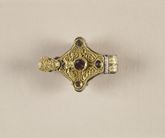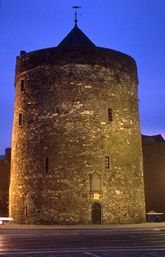Waterford
The Viking town of Waterford appears to have been founded around 914AD when it is recorded in the Fragmentary Annals of Ireland that 'a great fleet of Norwegians landed at Port Lairge and they plundered northern Osraige and brought spoils and many cows and livestock to their ships'.
Like Dublin, archaeological excavations in Waterford have produced a large amount of evidence for the late Viking Age and Medieval settlement. As is the case with other Viking towns in Ireland, it is situated at an easily-defended location bounded on the north by the river Suir. The name Waterford is derived from the Old Norse word for ram fjord or windy fjord.
A Viking city in 1000 A.D
Archaeological excavation in the 1980s revealed that Waterford was already a densely settled town by the mid-eleventh century, around the time that the Skuldelev 2 ship was built. The town was defended by a ditch and bank and streets fronted with houses were also in existence by this time. It appears that there were two main thoroughfares, roughly where Peter Street and High Street are today. A portion of the original surface of Peter Street was excavated and was found to measure over 2.5m wide. Its surface consisted of closely packed small stones. Houses in Waterford did face the street but were not arranged like a modern-day street front. There was variation in the orientation and position of houses, and street fronts were not always occupied by a house. Although actual boundary fences were not always found, there is evidence for continuity of plot orientation, as was the case in Dublin. Most of the houses in Waterford were of the three-aisled type, with clay floors and wattle walls, again comparable to the type found in Dublin. In some places, excavations showed that at least seven different houses had been superimposed on the one site, between the eleventh and the mid-twelfth century.
Finds from the excavations reveal the prosperity of some inhabitants – a beautiful kite-shaped brooch decorated with gold filigree was recovered from an eleventh century context. Pottery was imported from the south of England, and trade links were also maintained with north-west France. As in Dublin, archaeologists also found evidence for comb-making. A number of ship timbers were also found here.
By the early twelfth century Viking settlers in Waterford were Christian, and two churches are know to have existed – St. Olaf’s and St. Peter’s. Interestingly, the form of St. Peter’s church with a semicircular apse is unique in the context of parish churches in Ireland. Apses are a feature of Saxon churches in Britain, and the presence of this in Waterford indicates strong cultural links with England at this time.
Waterford’s defences appear to have been very extensive. Where excavated, the ditch measured up to 2.5m deep, and more than 8m wide in places. A large stone wall was built outside the ditch. The strength of the town’s fortifications is confirmed by twelfth century accounts, which state that it took Raymond Le Gros and Strongbow's forces three attempts to take the city. Reginald's tower, an Anglo-Norman building, may have been the location of an earlier Viking tower. It was in that tower that Ragnall, Prince of the Danes of Waterford, was imprisoned by the Normans in 1171.
By: Maeve Sikora, National Museum of Ireland
Literature
Ryan, M. (ed.) 1994. Irish Archaeology Illustrated.
Hurley, M., Scully, O.M.B., Cleary, R.M. & McCutcheon, SW.J. 1997. Late Viking Age and medieval Waterford. Excavations 1986-1992.

